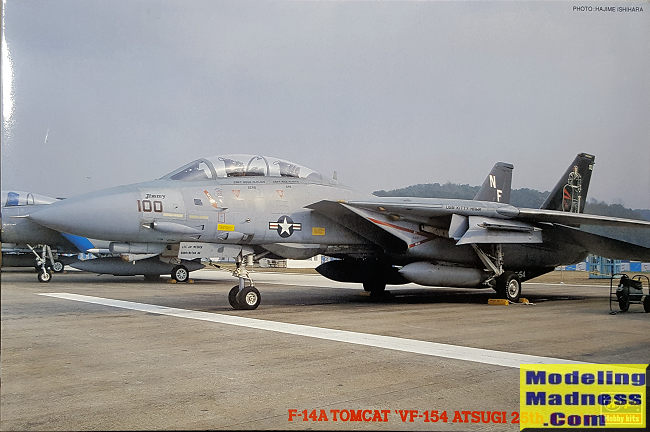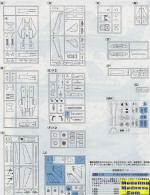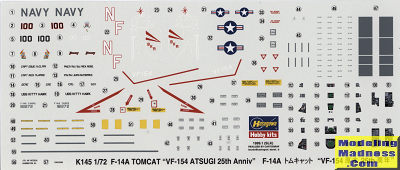
Hasegawa 1/72 F-14A 'VF-154 Atsugi 25th Anniversary'
| KIT #: | 04445 (K145) |
| PRICE: | 2400 yen SRP |
| DECALS: | One option |
| REVIEWER: | Scott Van Aken |
| NOTES: | 1999 Limited reissue |

| HISTORY |
The Grumman F-14 Tomcat is a supersonic, twin-engine, two-seat, variable-sweep wing fighter aircraft. The Tomcat was developed for the United States Navy's Naval Fighter Experimental (VFX) program following the collapse of the F-111B project. The F-14 was the first of the American teen-series fighters, which were designed incorporating the experience of air combat against MiG fighters during the Vietnam War.
The F-14 first flew in December 1970 and made its first deployment in 1974 with the U.S. Navy aboard USS Enterprise (CVN-65), replacing the McDonnell Douglas F-4 Phantom II. The F-14 served as the U.S. Navy's primary maritime air superiority fighter, fleet defense interceptor and tactical aerial reconnaissance platform. In the 1990s, it added the Low Altitude Navigation and Targeting Infrared for Night (LANTIRN) pod system and began performing precision ground-attack missions.[
In the 1980s F-14s were used as land-based interceptors by the Islamic Republic of Iran Air Force during the Iran–Iraq War, where they saw combat against Iraqi warplanes. Iranian F-14s reportedly shot down at least 160 Iraqi aircraft during the war, while only 12 to 16 Tomcats were lost; at least half of these losses were due to accidents.
The Tomcat was retired from the U.S. Navy's active fleet on 22 September 2006, having been supplanted by the Boeing F/A-18E/F Super Hornet. The F-14 remains in service with the Islamic Republic of Iran Air Force, having been exported to Iran in 1976, when the U.S. had amicable diplomatic relations with Iran.
VF-154 was aboard the USS Independence when it replaced the USS Midway in 1991. When its sister squadron, VF-21 was disestablished, 154 inherited most of its planes and personnel. In 1998, the Independence was replaced as the Japan based carrier by the USS Kittyhawk and VF-154 cross-decked to the new ship. In 2003, VF-154 left the Kittyhawk and the Tomcat, transitioning to the super bug.
| THE KIT |
As
demanded, the panel lines are engraved and the kit offers the ability to have
the flaps and slats deployed. In fact, to do it otherwise will require a bit of
surgery to be done on the slat tracks. You can also position the glove vanes
open or closed. Again, some surgery is needed for the closed position. All F-14s
had them wired in the closed position after it was realized that they didn't
really do anything and were an additional maintenance hassle. You also have the ability to have the speed brakes and entrance steps/ladder
open or closed, and two different tails, though one set is not for this
particular boxing. So much was the F-14 been modified and updated over the years
that you really need to have photographs of the aircraft that you are modeling
to get everything right.
 Hasegawa
has reboxed the Tomcat at least five dozen times, judging by my slowly
growing collection of F-14 kits. It was natural that they'd get the most out of
what has to have been an expensive molding, judging by the plethora of small
parts and inserts that come with the kits. There are so many parts that the box is actually bulging in an attempt to
keep them from escaping. You can see the number of bits and pieces from the
image above. In many ways, this is just a smaller version of the larger and
equally impressive 1/48 F-14 that Hasegawa has produced. Typical of Hasegawa,
the kit came with all those sprues in two bags. As a result, there were a number
of parts broken off the sprues and the bits have numerous scratches on them.
Hasegawa
has reboxed the Tomcat at least five dozen times, judging by my slowly
growing collection of F-14 kits. It was natural that they'd get the most out of
what has to have been an expensive molding, judging by the plethora of small
parts and inserts that come with the kits. There are so many parts that the box is actually bulging in an attempt to
keep them from escaping. You can see the number of bits and pieces from the
image above. In many ways, this is just a smaller version of the larger and
equally impressive 1/48 F-14 that Hasegawa has produced. Typical of Hasegawa,
the kit came with all those sprues in two bags. As a result, there were a number
of parts broken off the sprues and the bits have numerous scratches on them.  As required by its price, this kit comes with a small fret of
etched metal. These bits are for the interior, canopy and exhaust. The metalwork
is very well done and should really enhance your Tomcat. For this kit, they
supply the standard F-14A 'Pacific Fleet Squadrons' instruction sheet and an addendum sheet
for the decals and differences between the base boxing and this kit. The
instructions are very well done as you would expect. They offer color callouts
based on Gunze paint as is the norm with Hasegawa over the last decades.
As required by its price, this kit comes with a small fret of
etched metal. These bits are for the interior, canopy and exhaust. The metalwork
is very well done and should really enhance your Tomcat. For this kit, they
supply the standard F-14A 'Pacific Fleet Squadrons' instruction sheet and an addendum sheet
for the decals and differences between the base boxing and this kit. The
instructions are very well done as you would expect. They offer color callouts
based on Gunze paint as is the norm with Hasegawa over the last decades.
 For markings, we have
a single option as shown on the box top. This is the CAG bird from VF-154. It is not surprising that
VF-154 has been the subject of many of Hasegawa's limited edition kits. It is,
by the fact that the unit was home ported in Japan, a Japanese subject and so it
quite popular with the local buying public. Decals are nicely done and
should cause no issues on application.
For markings, we have
a single option as shown on the box top. This is the CAG bird from VF-154. It is not surprising that
VF-154 has been the subject of many of Hasegawa's limited edition kits. It is,
by the fact that the unit was home ported in Japan, a Japanese subject and so it
quite popular with the local buying public. Decals are nicely done and
should cause no issues on application.
| CONCLUSIONS |
You can add this one to a growing list of Hasegawa limited reissue kits. I guess it is a good way to do business as they seem to sell rather well. I'm surprised at how well these molds have held up. The final result of the build is a superb model of an important US fighter.
| REFERENCES |
http://en.wikipedia.org/wiki/F-14_Tomcat
April 2024
Copyright ModelingMadness.com. All rights reserved. No reproduction in part or in whole without express permission from the editor.
If you would like your product reviewed fairly and quickly, please contact the editor or see other details in the Note to Contributors.